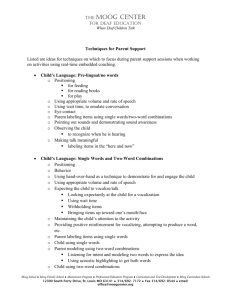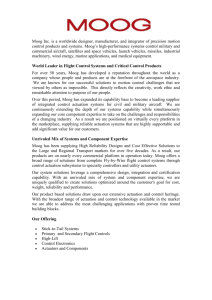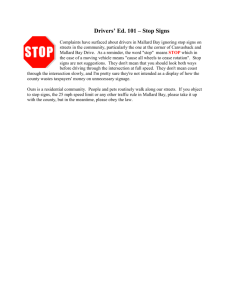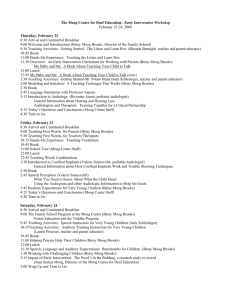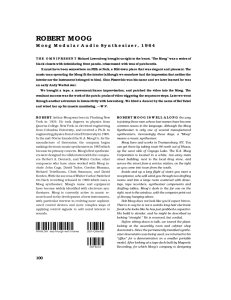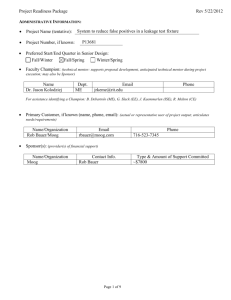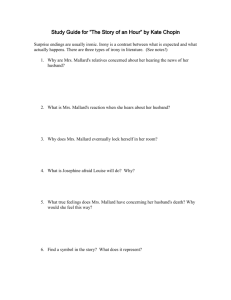Press release - Cuneiform Records
advertisement
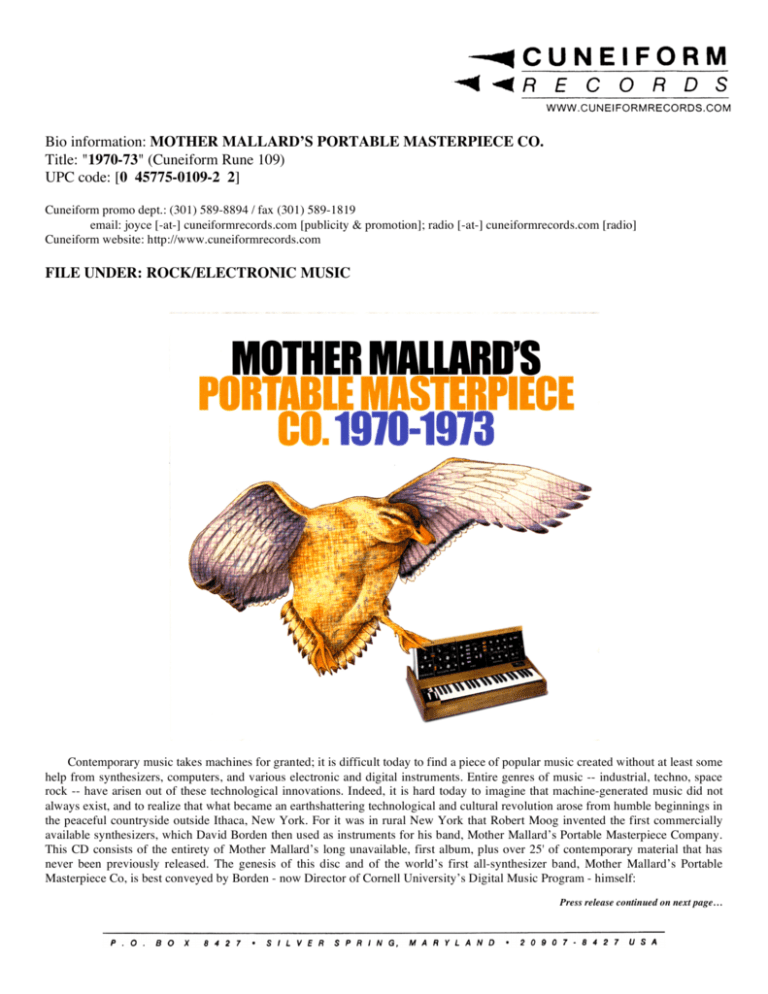
Bio information: MOTHER MALLARD’S PORTABLE MASTERPIECE CO. Title: "1970-73" (Cuneiform Rune 109) UPC code: [0 45775-0109-2 2] Cuneiform promo dept.: (301) 589-8894 / fax (301) 589-1819 email: joyce [-at-] cuneiformrecords.com [publicity & promotion]; radio [-at-] cuneiformrecords.com [radio] Cuneiform website: http://www.cuneiformrecords.com FILE UNDER: ROCK/ELECTRONIC MUSIC Contemporary music takes machines for granted; it is difficult today to find a piece of popular music created without at least some help from synthesizers, computers, and various electronic and digital instruments. Entire genres of music -- industrial, techno, space rock -- have arisen out of these technological innovations. Indeed, it is hard today to imagine that machine-generated music did not always exist, and to realize that what became an earthshattering technological and cultural revolution arose from humble beginnings in the peaceful countryside outside Ithaca, New York. For it was in rural New York that Robert Moog invented the first commercially available synthesizers, which David Borden then used as instruments for his band, Mother Mallard’s Portable Masterpiece Company. This CD consists of the entirety of Mother Mallard’s long unavailable, first album, plus over 25' of contemporary material that has never been previously released. The genesis of this disc and of the world’s first all-synthesizer band, Mother Mallard’s Portable Masterpiece Co, is best conveyed by Borden - now Director of Cornell University’s Digital Music Program - himself: Press release continued on next page… “Mother Mallard History: The Early Years” by David Borden Moog’s Chief Idiot In 1966-68 I was composer-in-residence for the Ithaca City School District. I had come directly from West Berlin, Germany where I had been studying as a Fulbright student. In 1967 I introduced myself to Bob Moog whom I had heard about from several people around Ithaca. Bob had his company in Trumansburg which is a twenty minute drive from Ithaca. Bob was happy to see someone interested in learning and using his new invention, the voltage-controlled electronic synthesizer. To me, it looked like the cockpit of an airplane and hopelessly complicated. Bob though, took me under his wing and patiently taught me how to use it although I ruined some of his modules along the way. In fact, I hooked them up in such a bizarre way, not understanding what I was doing, that they redesigned several of the modules having not anticipated someone as totally unaware of the principles behind the design as I was. Otherwise they could have been facing many returned ynthesizers burned out by neophytes likes me. I didn't realize Bob was using me as a test person until several months later when it was clear that I finally knew what I was doing. He explained that I helped in the research to idiot-proof the soon-to-be famous Moog Synthesizer. I had been chief idiot, which upon reflection, I enjoyed immensely. Physical Education Instructor? By 1968 I was hired by Cornell University as Composer-Pianist for Dance. Since the dance program was part of the Women's Physical Education Program which in turn was administered by the Department of Athletics, we were a very insignificant part of the operation, and although my title looked good on paper, in reality I was listed in the directory as a Phys. Ed Instructor. I later learned that this was the lowest paying staff job at Cornell. But the good thing was, I had no administrative responsibilities, no meetings to attend and had only to prepare for teaching one half of one class; the rest was improvisation which I had been doing since I was ten years old. This left me plenty of time to work late into the night at the Moog Company (Bob had given me a key to the place long before) discovering new ways to compose using the huge modular Moog and the four-track Scully tape recorder. Soon, I was using the synthesizer in all of my compositions including the ones I did for dance concerts as part of my job. Forever Changed As part of my new job, Peggy Lawler, the primary dance instructor/choreographer would arrange for students and staff (she and I) to travel to New York City to see modern dance concerts. This is when I discovered Merce Cunningham and the musicians around him including John Cage, Gordon Mumma, David Behrman and David Tudor. Seeing them perform live electronic music forever changed my way of thinking about performing music. Especially electronic music. Up until then, I thought of it as making tapes in a studio; after that I always thought of electronic music as something to be performed live, even if occasionally pre-recorded tapes were involved. In 1969 the Cunningham Company visited Ithaca for a performance and some dance workshops. It was then that I got to know Gordon Mumma and David Tudor who would later participate in one of the first performances of CLOUDSCAPE FOR PEGGY (composed for Peggy Lawler's choreography in 1970) which was one of my first all-synthesizer pieces designed for live performance. Late in 1968 I decided to start my own live electronic (and amplified acoustic) group for giving live concerts. I wanted to present very new and startling work. I remember getting ideas from Mumma and Tudor as well as SOURCE Magazine, which was an avant garde music publication out of Davis California which featured new pieces by young composers. New Ensemble, New Name One of the first things I thought about was a name for the new ensemble. I wanted it to be ironic in some way. I certainly didn't want an academic sounding name. It was on my mind almost constantly for several days. During this time, while shopping in a supermarket, I leaned over the frozen food section and the friendly senior-citizen face of Mrs. Smith of Mrs. Smith's Frozen Pies hit me and immediately I thought of my own grandmother, Lena Belle Mallard. She was called Mother Mallard because she had had her picture taken for the Boston papers to show five generations of Mallards of which she was the progenitor. So OK, Mother Mallard had a nice alliteration, but what else? The word "masterpiece" followed because it began with an "m", and besides we were always joking about how it was no longer necessary nor desirable to think in terms of masterpieces. So now I had the image I wanted; a friendly grandmother behind which we would perform outrageous pieces like Robert Ashley's WOLFMAN, a feedback assault on the ears while miming the movements of a crooner. A couple of days later the word "portable" was inserted before "masterpiece" as an added oxymoronic juxtaposition. Mother Mallard's Portable Masterpiece Co. was born. Our first concert was in May of 1969 in Barnes Hall on the Cornell University campus. The concert included WOLFMAN by Ashley, PITCH OUT by Allen Bryant (for which Bard Prentiss made the amplified string instruments played with metal bars and files), a piece by Dan Lentz which included a sinister looking man (Steve Drews) taking collection in the audience, and finally some "classic" pieces by Morton Feldman and John Cage. The audience loved it. Live Electronic Performance After this, I planned to compose pieces for live electronic performance using synthesizers. I talked with Bob Moog, and he agreed to let us use whatever was available. My approach to composition was changing quickly away from the complex atonal methods being taught in most universities at the time, to a simpler, tonal way of doing things. I had been very impressed with Terry Riley's IN C, so I started to work with drones and complex rhythms, bringing my jazz background into play. Easter Sunday 1970 My work as a dance accompanist was affected by this also, as I tried out various repeated patterns as part of my daily job. Then later at night I would work themout at the Moog Studio. Using the four-track tape recorder also appealed to me because it accentuated the contrapuntal approach I had always favored when composing. Now I could compose one person's part all the way through, and then add another person's part on top with each part retaining its individual integrity. This technique is commonly called layering, but this kind of layering was more extreme-like working with a cantus firmus, a very old medieval idea. My first tonal steady pulse piece for the Moog was EASTER which was composed for a dance student in April of 1970. I finished it a few days before Easter, hence the title. Steve Drews and I performed it live with tape at Sage Chapel on the Cornell campus on Easter Sunday, 1970. This was the first live performance using a MiniMoog. We had the prototype. Mini Moog Makes Its New York City Debut At about this time, Moog got a call from someone at Trinity Church in Manhatten asking if he could recommend or supply a live performance involving the Moog Synthesizer for one of their Lunchtime Concerts. By this time Moog was becoming famous as an inventor due to the brisk sales of SWITCHED-ON BACH, an LP release by Walter Carlos on Columbia Records. It was a collection of Bach classics realized on the Moog. It made the cover of TIME Magazine. So Bob recommended me, and I asked Steve Drews to play EASTER with me, using a prepared tape. This was the first public performance in New York City using a MiniMoog. Even though the official debut of the MiniMoog was months away (by Dick Hyman), we took the prototype with us to New York. When we got to Trinity Church we found out that we hadn't been billed as Mother Mallard or David Borden but as THE MOOG SYNTHESIZER. This kind of billing would dominate our appearances for the first few years, because no one else was performing with Moog Synthesizers except for Walter Carlos and Richard Teitlebaum. Carlos almost never performed live and Teitlebaum was in Europe. The Summer of 1970 During the summer of 1970 I worked Summer School and was Barbara Lloyd's accompanist. She was one of Cunningham's star soloists and is now known as Barbara Dilley. She has been president of Naropa Institute. Working with Barbara was a joy, and I often brought a Moog to the dance studio to improvise live on. I also worked with visiting filmmaker Ed Emshwiller and did the soundtrack for his film BRANCHES which he produced hurriedly with summer students. In addition, I composed CLOUDSCAPE FOR PEGGY for an Ithaca College performance by Peggy Lawler. It was during this summer that I really got to know Gordon Mumma, who greatly enhanced my knowledge of the perils of live electronic performance. At the time, he saw to it that all of John Cage's ideas for Cunningham were realized electronically. The going joke was that Cage, whom everyone loved, and who was the pioneer of live electronic performance had trouble plugging in his electric razor. So Gordon took care of the technical problems. Steve Reich was another visitor to Ithaca that summer. Cornell was his alma mater, and he was also interested in seeing the Moog Studio. We have been friends ever since. Finally, Phil Glass passed through Ithaca the following fall resulting in a friendship that still continues. Steve Begins Composing & Linda Joins Up During the summer of 1970, Steve Drews also started composing pieces for Live performance using Moog Synthesizers. With the pieces I had done for the Cornell Dance Program, plus Steve's new pieces, we had enough for an entire program of our own music using nothing but Moogs with an occasional guest performer on another instrument. We asked Linda Fisher to join us in giving some concerts. She agreed, and in 1971 finally agreed to become a permanent member, contributing her RMI Electric Piano as well. The Moog Company kept receiving requests for concerts and/or demonstrations, so they would always recommend us. That's how we started travelling around giving concerts. We also made a deal to buy several synthesizers over a four year period. We had gone to local banks for a loan, but were unsuccessful. So Bob let us pay him with quarterly payments, and refused to charge us interest. The End of an Era In the fall of 1971 Bob Moog, facing bankruptcy, decided to sell his company to a businessman in Buffalo, New York rather than see all of his customers go without technical support for the units he had sold them. Even with his fame, musicians were not flocking to buy his synthesizer, and music stores were still reluctant to stock them. So sadly, Bob left Trumansburg, and for five years was a techno-slave for the new owners, doing some PR and mostly uninteresting technical work. When Bob hit zero (i.e., out of debt) five years later, he threw a big party. In the years that followed he founded another business called Big Briar (he had signed away the right to use his own name in a business title) and then spent several years as a research vice-president for Kurzweil. He still heads up Big Briar, making theremins and other musical-electronic devices for live performance. Hopefully he will soon be able to use his name again on his business logo. A Farmhouse, Patch Cord Drills, and The Snowstorm When Bob left the area, Mother Mallard rented a rural farmhouse in Enfield, NY, between Trumansburg and Ithaca. Chris Swanson, a jazz composer and recent user of the Moog Studio, found the place. It was perfect. Quiet, isolated and with low rent. Together we shared the place as our work studio. Chris worked mornings and afternoons. We took the nights. It was here that we really came into our own, rehearsing almost every night, drilling ourselves on how quickly we could change the dozens of patch cords between pieces and blindly set up intricate sounds (i.e., without testing them audibly before playing them). During the winter of 197172, Merce Cunningham came to Binghamton which is an hour from Ithaca. With him came some additional staff: his touring manager Jane Yockel and his costume manager, Margaret Wood. Margaret had been part of the Cornell Dance Program. She drove from Binghamton and brought Jane for dinner at my house. No sooner had they arrived than one of the worst blizzards in Finger Lakes history hit. Jane and Margaret were snowed in with us for four days and nights. This turned out to be a blessing. Jane and Margaret, in partnership with Mimi Johnson, (a young woman who managed John Cage's affairs) were in the midst of starting their own managing team for performing avant garde artists. Performing Arts Services was partially born under my own roof, and soon Mother Mallard was one of their first clients. It was through the efforts of Artservices, as it became known, that MMPMC began to be frequent performers in various SoHo performance spaces, as well as the WBAI Free Music Store. These appearances got us reviews in several places including the NY Times. We also reached a much wider audience than we would have otherwise. Synthesizer Music? Trance Music? or Nothing Happening? During this time, Steve and I (and sometimes Linda) composed new pieces to perform. A few of our pieces, like Steve's CERES MOTION employed the use of a mobius strip tape loop. Gordon Mumma turned us on to these. They came in various time lengths. You could tape something live and at the end of the tape, turn off the record button and play it back instantly. Each of us had a stopwatch to keep track of the loop lengths. The first part of CERES MOTION is what is now commonly called a pad. We recorded the pad (around 5 minutes), played it back instantly, and being a loop, it would go on forever until we turned off the tape recorder. When the pad is played back for the first time, the piece changes into an up tempo mantra with Steve improvising patterns on a Modular Moog and with his non-playing hand, adjusting the knobs of a fixed filter bank accentuating different harmonics for each section. Steve found very exotic an beautiful sounds on the Moogs, and was a master performer on the ribbon controller. My stuff kept to more simple sounds with the emphasis on multi-metered contrapuntal figures that repeated at different time lengths. In the early 70s, this kind of music was not yet called minimalism. So critics would refer to it as "synthesizer music" , "trance music" or simply deride it as boring because "nothing happened". Earthquack Records is Born By the fall of 1972 we had developed enough music to perform three or four concerts without repeating anything. We started looking around for a recording label. The audiences loved our concerts, and we thought our music was as good as any other new music, and that our performances had achieved a professional polish while at the same time sounding fresh and original. We made many phone calls, talked with many record executives, sent out countless demo tapes to no avail. After several months of no takers, I decided to start my own record company. Margaret Wood at Artservices thought it was a great idea. The only problem was, I only had half the money I needed. Margaret had looked into the costs of mastering, pressing and cover printing. I forget how much this amount was, but it was something like $1500. I only had half, and couldn't get a loan. One of the people I approached about becoming a partner in starting a record company was Elliot Saltzman, a very funny guy, and recent Cornell graduate who had started his own advertising agency. He declined, but talked to Judy Borsher about it who was interested. She called me out of the blue, but I was reluctant because she was still a student and didn't want it to appear like I was taking advantage of a younger person who stood a good chance of losing her investment. Unknown to me at the time, Judy had been deeply moved by the music we were making, so she welcomed an opportunity to get involved with the production of our work. Judy, who would later take Linda Fisher's place in Mother Mallard, made it possible to start Earthquack Records. Mother Mallard as an image had long ago gone from a friendly senior citizen to a duck. In fact, fans used to give us various duck gifts at concerts. So we went with it. We had a duck decoy perched on top of one of the synthesizers. The first LP was "in the can" by early fall, but due to delays in printing the cover and pressing the disks, the first LPs weren't available until late January of 1974. We had it distributed through JCOA (Jazz Composer's Orchestra Association), a group pioneered by jazz composer Carla Bley. Artservices, seeing that producing independent LPs and getting them distributed was not as difficult as they had imagined, started Lovely Music modeled after this first Earthquack LP. The Exorcist Meanwhile, director Billy Friedkin had heard some re-broadcasts of our WBAI Free Music Store concerts and was interested in having me compose music for his new horror film. We were all invited to the cast party of the EXORCIST at the end of shooting, and Billy introduced us around to everyone as the people who were doing the soundtrack. In the end, he would use only three short pieces I did for THE EXORCIST. He asked me if I was considering a move to Hollywood, and I said no. 1973 ended with offers from both Hollywood and Europe. I didn't want to go to Hollywood, Steve didn't want to go to Europe and Linda wanted to do her own thing. A few months after that film party in Manhatten, Mother Mallard would change forever. Major Changes In 1974, after having turned down an offer to tour Europe, and deciding not to relocate in Hollywood, Mother Mallard continued the same circuit. In New York City, the WBAI Free Music Store and downtown venues like the Paula Cooper Gallery, the Kitchen, and various lofts. Otherwise, there were college an university concerts, mostly in the northeast. By the end of 1974 Linda let us know that she wanted to pursue her own path and by the summer of 1975 Judy Borsher joined us. There were a couple of interim keyboardists, but they were just temporary replacements. Judy had become part of the Mother Mallard "family" and had spent some time at rehearsals at our country studio. What I didn't know was that when we weren't there she would sometimes sit at the keyboards and the play the parts. Judy proved to be excellent in every way, surprising us with her fluid keyboard technique and rapid grasp of the technology. By the end of 1975 Steve Drews decided he wanted to give up music and pursue a career in photography (he has his own successful photography studio in St. Louis). He was replaced by Chip Smith, a wonderful keyboardist who had played with Chuck Berry, including his Carnegie Hall concert. This group has remained in my memory with great affection. Parts 5-8 of the Continuing Story of Counterpoint were written especially for this ensemble. After several months Steve left Ithaca and withdrew his pieces from our repetoire. From that point until now, Mother Mallard has played only my compositions. Also with this group, I shouldered the financial responsibilities for all of the music equipment except for Chip Smith's Fender Rhodes which was the second polyphonic keyboard in our collection. When Linda Fisher left, I bought her RMI Piano. Now Mother Mallard had three Modular Moogs, two MiniMoogs, and the two electric pianos. Judy contributed her van for our transportation and her tremendous organizational business sense in finding funds, booking and managing our concerts. Although we were constantly broke, we really enjoyed touring and playing. This group was the last of the Moog-based bands. Unfortunately we never made a studio recording although there are some live tapes somewhere from a few concerts. It lasted from late 1975 to the summer of 1978. I then decided to spend more time with my family and give up the band for awhile. "In 1966-68 I was composer-in-residence for the Ithaca City School District in NY. I had come directly from West Berlin, Germany where I had been studying as a Fulbright student. In 1967 I introduced myself to Bob Moog whom I had heard about from several people around Ithaca. Bob had his company in Trumansburg which is a twenty minute drive from Ithaca. Bob was happy to see someone interested in learning and using his new invention, the voltage-controlled electronic synthesizer. To me, it looked like the cockpit of an airplane and hopelessly complicated. Bob took me under his wing and patiently taught me how to use it, although I ruined some of his modules along the way. In fact, I hooked them up in such a bizarre way, not understanding what I was doing, that they redesigned several of the modules, not having anticipated someone as totally unaware of the principles behind the design as I was. Otherwise they could have been facing many returned synthesizers burned out by neophytes likes me. I didn't realize Bob was using me as a test person until several months later when it was clear that I finally knew what I was doing. He explained that I helped in the research to idiot-proof the soon-to-be famous Moog Synthesizer. I had been chief idiot, which upon reflection, I enjoyed immensely. By 1968 I was hired by Cornell University as Composer-Pianist for Dance. Since the dance program was part of the Women's Physical Education Program which in turn was administered by the Department of Athletics, we were a very insignificant part of the operation, and although my title looked good on paper, in reality I was listed in the directory as a Phys. Ed Instructor. I later learned that this was the lowest paying staff job at Cornell. But the good thing was, I had no administrative responsibilities, no meetings to attend and had only to prepare for teaching one half of one class; the rest was improvisation which I had been doing since I was ten years old. This left me plenty of time to work late into the night at the Moog Company (Bob had given me a key to the place long before) discovering new ways to compose using the huge modular Moog and the four-track Scully tape recorder. Soon, I was using the synthesizer in all of my compositions including the ones I did for dance concerts as part of my job. As part of my new job, Peggy Lawler, the primary dance instructor/choreographer would arrange for students and staff (she and I) to travel to New York City to see modern dance concerts. This is when I discovered Merce Cunningham and the musicians around him including John Cage, Gordon Mumma, David Behrman and David Tudor. Seeing them perform live electronic music forever changed my way of thinking about performing music. Especially electronic music. Up until then, I thought of it as making tapes in a studio; after that I always thought of electronic music as something to be performed live even if occasionally pre-recorded tapes were involved. In 1969 the Cunningham Company visited Ithaca for a performance and some dance workshops. It was then that I got to know Gordon Mumma and David Tudor who would later participate in one of the first performances of CLOUDSCAPE FOR PEGGY (composed for Peggy Lawler's choreography in 1970) which was one of my first all-synthesizer pieces designed for live performance. Late in 1968 I decided to start my own live electronic (and amplified acoustic) group for giving live concerts. I wanted to present very new and startling work. I remember getting ideas from Mumma and Tudor as well as Source Magazine, which was an avant garde music publication out of Davis California which featured new pieces by young composers. One of the first things I thought about was a name for the new ensemble. I wanted it to be ironic in some way. I certainly didn't want an academic sounding name. It was on my mind almost constantly for several days. During this time, while shopping in a supermarket, I leaned over the frozen food section and the friendly senior-citizen face of Mrs. Smith of Mrs. Smith's Frozen Pies hit me and immediately I thought of my own grandmother, Lena Belle Mallard. She was called Mother Mallard because she had had her picture taken for the Boston papers to show five generations of Mallards of which she was the progenitor. So OK, Mother Mallard had a nice alliteration, but what else? The word "masterpiece" followed because it began with an "m", and besides we were always joking about how it was no longer necessary nor desirable to think in terms of masterpieces. So now I had the image I wanted; a friendly grandmother behind which we would perform outrageous pieces like Robert Ashley's WOLFMAN, a feedback assault on the ears while miming the movements of a crooner. A couple of days later the word "portable" was inserted before "masterpiece" as an added oxymoronic juxtaposition. Mother Mallard's Portable Masterpiece Co. was born. Our first concert was in May of 1969 in Barnes Hall on the Cornell University campus. The concert included WOLFMAN by Ashley, PITCH OUT by Allen Bryant (for which Bard Prentiss made the amplified string instruments played with metal bars and files), a piece by Dan Lentz which included a sinister looking man (Steve Drews) taking collection in the audience, and finally some "classic" pieces by Morton Feldman and John Cage. The audience loved it. After this, I planned to compose pieces for live electronic performance using synthesizers. I talked with Bob Moog, and he agreed to let us use whatever was available. My approach to composition was changing quickly away from the complex atonal methods being taught in most universities at the time, to a simpler, tonal way of doing things. I had been very impressed with Terry Riley's IN C, so I started to work with drones and complex rhythms, bringing my jazz background into play. My work as a dance accompanist was affected by this also, as I tried out various repeated patterns as part of my daily job. Then later at night I would work them out at the Moog Studio. Using the four-track tape recorder also appealed to me because it accentuated the contrapuntal approach I had always favored when composing. Now I could compose one person's part all the way through, and then add another person's part on top with each part retaining its individual integrity. This technique is commonly called layering, but this kind of layering was more extreme - like working with a cantus firmus, a very old medieval idea. My first tonal steady pulse piece for the Moog was EASTER which was composed for a dance student in April of 1970. I finished it a few days before Easter, hence the title. Steve Drews and I performed it live with tape at Sage Chapel on the Cornell campus on Easter Sunday, 1970. This was the first live performance using a MiniMoog. We had the prototype. At about this time, Moog got a call from someone at Trinity Church in Manhatten asking if he could recommend or supply a live performance involving the Moog Synthesizer for one of their Lunchtime Concerts. By this time Moog was becoming famous as an inventor due to the brisk sales of SWITCHED-ON BACH, an LP release by Walter Carlos on Columbia Records. It was a collection of Bach classics realized on the Moog. It made the cover of Time magazine. So Bob recommended me, and I asked Steve Drews to play EASTER with me, using a prepared tape. This was the first public performance in New York City using a MiniMoog. Even though the official debut of the MiniMoog was months away (by Dick Hyman), we took the prototype with us to New York. When we got to Trinity Church we found out that we hadn't been billed as Mother Mallard or David Borden but as THE MOOG SYNTHESIZER. This kind of billing would dominate our appearances for the first few years, because no one else was performing with Moog Synthesizers except for Walter Carlos and Richard Teitlebaum. Carlos almost never performed live and Teitlebaum was in Europe. During the summer of 1970 I worked Summer School and was Barbara Lloyd's accompanist. She was one of Cunningham's star soloists and is now known as Barbara Dilley. Working with Barbara was a joy, and I often brought a Moog to the dance studio to improvise live on it. I also worked with visiting filmmaker Ed Emshwiller and did the soundtrack for his film BRANCHES which he produced hurriedly with summer students. I also composed CLOUDSCAPE FOR PEGGY for an Ithaca College performance by Peggy Lawler. It was during this summer that I really got to know Gordon Mumma (he was involved with Barbara at the time) who greatly enhanced my knowledge of the perils of live electronic performance. At the time, he saw to it that all of John Cage's ideas for Cunningham were realized electronically. The going joke was that Cage, whom everyone loved, and who was the pioneer of live electronic performance had trouble plugging in his electric razor. So Gordon took care of the technical problems. Steve Reich was another visitor to Ithaca that summer. Cornell was his alma mater, and he was also interested in seeing the Moog Studio. We have been friends ever since. Finally, Phil Glass passed through Ithaca the following fall resulting in a friendship that still continues. At this time MMPMC consisted of Steve Drews, Bard Prentiss (a sculptor) and me. We depended on the volunteer efforts of friends to fill out the ensemble as needed. We all had a lot of fun, although it was hard work. It wasn't until our next concert in the fall of 1970 that we again used Moog Synthesizers live. Linda Fisher joined us for this concert as a guest performer. For this concert we played Steve Reich's PIANO PHASE on synthesizers (with his blessing) and Philip Glass's MUSIC IN FIFTHS on synthesizers (with his special permission), Terry Riley's IN C (again, including synthesizers), Robert Ashley's SHE WAS A VISITOR, and Jon Hassel's SUPER BALL (both entailed a lot of work, but included no synthesizers). This was when we really learned how difficult the Moog Synthesizer was to control in concert because it drifted in and out of tune with the temperature. This not only affected the absolute pitch, but also the octave settings (octaves could expand or shrink, so that tuning a C to a C in one octave didn't make much difference). So, since the Moogs were all monophonic, we kept one hand free to adjust the pitch and octave settings whose controls were changed with knobs found on the left side of the keyboard. We played the notes with our other hand. During the summer of 1970, Steve Drews also started composing pieces for live performance using Moog Synthesizers. With the pieces I had done for the Cornell Dance Program, plus Steve's new pieces, we had enough for an entire program of our own music using nothing but Moogs with an occasional guest performer on another instrument. We asked Linda Fisher to join us in giving some concerts. She agreed, and in 1971 finally agreed to become a permanent member, contributing her RMI Electric Piano as well. The Moog Company kept receiving requests for concerts and/or demonstrations, so they would always recommend us. That's how we started travelling around giving concerts. We also made a deal to buy several synthesizers over a four year period. We had gone to local banks for a loan, but were unsuccessful. So Bob let us pay him with quarterly payments, and refused to charge us interest. In the fall of 1971 Bob Moog, facing bankruptcy, decided to sell his company to a businessman in Buffalo, New York rather than see all of his customers go without technical support for the units he had sold them. Even with his fame, musicians were not flocking to buy his synthesizer, and music stores were still reluctant to stock them. So sadly, Bob left Trumansburg, and for five years was a techno-slave for the new owners, doing some PR and mostly uninteresting technical work. When Bob got out of debt five years later, he threw a big party. In the years that followed he founded another business called Big Briar (he had signed away the right to use his own name in a business title) and then spent several years as a research vice-president for Kurzweil. He still heads up Big Briar, making theremins and other musical-electronic devices for live performance. Hopefully he will soon be able to use his name again on his business logo. When Bob left the area, Mother Mallard rented a rural farmhouse in Enfield, NY, between Trumansburg and Ithaca. Chris Swanson, a jazz composer and recent user of the Moog Studio, found the place. It was perfect. Quiet, isolated and with low rent. Together we shared the place as our work studio. Chris worked mornings and afternoons. We took the nights. It was here that we really came into our own, rehearsing almost every night, drilling ourselves on how quickly we could change the dozens of patch cords between pieces and blindly set up intricate sounds (i.e., without testing them audibly before playing them). During the winter of 197172, Merce Cunningham came to Binghamton which is an hour from Ithaca. With him came some additional staff: his touring manager Jane Yockel and his costume manager, Margaret Wood. Margaret had been part of the Cornell Dance Program. She drove from Binghamton and brought Jane for dinner at my house. No sooner had they arrived than one of the worst blizzards in Finger Lakes history hit. Jane and Margaret were snowed in with us for four days and nights. This turned out to be a blessing. Jane and Margaret, in partnership with Mimi Johnson, (a young woman who managed John Cage's affairs) were in the midst of starting their own managing team for performing avant garde artists. Performing Arts Services was partially born under my own roof, and soon Mother Mallard was one of their first clients. It was through the efforts of Artservices, as it became known, that MMPMC began to be frequent performers in various SoHo performance spaces, as well as the WBAI Free Music Store. These appearances got us reviews in several places including The NY Times. We also reached a much wider audience than we would have had otherwise. During this time, Steve and I (and sometimes Linda) composed new pieces to perform. A few of our pieces, like Steve's CERES MOTION employed the use of a mobius strip tape loop. Gordon Mumma turned us on to these. They came in various time lengths. You could tape something live and at the end of the tape, turn off the record button and play it back instantly. Each of us had a stopwatch to keep track of the loop lengths. The first part of CERES MOTION is what is now commonly called a pad. Steve and I recorded the pad (around 5 minutes), played it back instantly, and being a loop, it would go on forever until we turned off the tape recorder. When the pad is played back for the first time, the piece changes into an up tempo mantra with Steve improvising patterns on a Modular Moog and with his non playing hand, adjusting the knobs of a fixed filter bank accentuating different harmonics for each section. Steve found very exotic an beautiful sounds on the Moogs, and was a master performer on the ribbon controller. My stuff kept to more simple sounds with the emphasis on multi-metered contrapuntal figures that repeated at different time lengths. In the early 70s, this kind of music was not yet called minimalism. So critics would refer to it as "synthesizer music" , "trance music" or simply deride it as boring because "nothing happened". By the fall of 1972 we had developed enough music to perform three or four concerts without repeating anything. We started looking around for a recording label. The audiences loved our concerts, and we thought our music was as good as any other new music, and that our performances had achieved a professional polish while at the same time sounding fresh and original. We made many phone calls, talked with many record executives, sent out countless demo tapes to no avail. Eventually, I decided to start my own record company. Margaret Wood at Artservices thought it was a great idea. The only problem was, I only had half the money I needed. Margaret had looked into the costs of mastering, pressing and cover printing. I forget how much this amount was, but it was something like $1500. I only had half, and couldn't get a loan. One of the people I approached was Elliot Saltzman, a very funny guy & recent Cornell graduate who had started his own advertising agency. He declined, but mentioned it in passing to his friend Judy Borscher. She called me out of the blue, but I was reluctant because she was still a student and I didn't want it to appear like I was taking advantage of a younger person who stood a good chance of losing her investment. Unknown to me at the time, Judy had become deeply moved by the music we were making, so she welcomed an opportunity to get involved with the production of our work. Judy, who would later take Linda Fisher's place in Mother Mallard, made it possible to start Earthquack Records. Mother Mallard as an image had long ago gone from a friendly senior citizen to a duck. In fact, fans used to give us various duck gifts at concerts. So we went with it. We had a duck decoy perched on top of one of the synthesizers. The first LP was "in the can" by early fall, but due to delays in printing the cover and pressing, the first LPs weren't available until late January of 1974. Artservices, seeing that producing independent LPs and getting them distributed was not as difficult as they had imagined, started Lovely Music modeled after this first Earthquack LP." - David Borden, 1998
